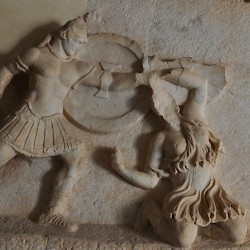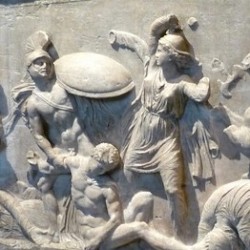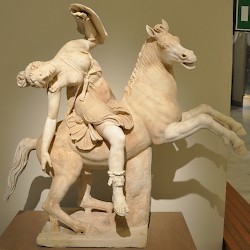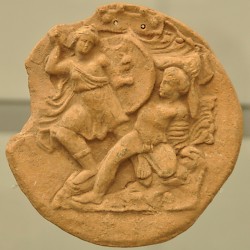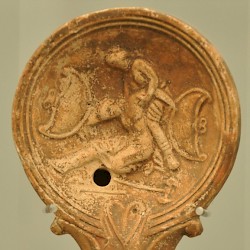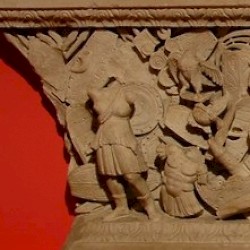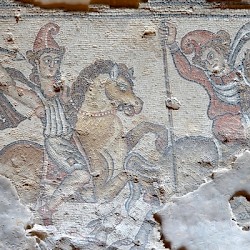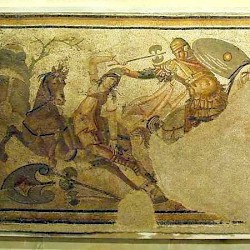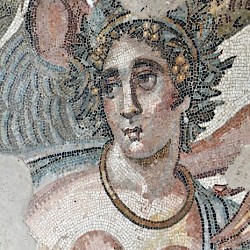Amazons
Amazons (Greek Ἀμαζόνες): in Greek myth, a foreign nation of female warriors.
Foreign Female Fighters

The first record of the Amazons in Greek literature can be found in Homer’s Iliad, in which the female warriors are called ἀντιάνειραι, “equal to men”.note The sequel to the Iliad, the (lost) Aethiopis by Arctinus of Miletus, begins with the arrival of the Amazon queen Penthesileia, “a daughter of Ares and of Thracian race” according to Proclus’ summary, who is a valiant fighter but is killed by Achilles. While the Trojans are burying her, one of the Greek soldiers, Thersites, blabs out that Achilles had been in love with the dead Amazon. The ancient artists knew a good story when they heard one: representations of Achilles and Penthesileia usually show them looking into each other's eyes.

This story is typical for many myths about Amazons: a foreign, female warrior challenges a Greek, male hero like Bellerophon, Heracles, Theseus and the Athenians, even Alexander the Great. Because opposites attract, there’s usually also an erotic aspect. It is hard not to recognize the sexual metaphor when Heracles is supposed to take away the girdle of Amazon queen Hippolyta.
Foreign Countries
In a second type of story, Amazons give their names to cities abroad: Cyrene (a Greek colony in Libya) and Sinope (a Greek colony on the shores of the Black Sea) for example, and Smyrna (believed to be a Greek colony). Again, we see that the Amazon is associated with foreign countries, just like Homer’s Thracian origin of Penthesileia.
In his Prometheus Bound, fifth-century playwright Aeschylus placed the Amazons near Lake Maeotis (southern Scythia), while his younger contemporary Herodotus sought the homeland of the Amazons on the banks of a river Thermodon, which he situates in Scythia. Alexander the Great supposedly met his Amazon in Hyrcania; Strabo places the Thermodon in what we call northern Turkey.
Background
A very unusual and interesting tradition is recorded by Diodorus of Sicily,note who refers to a tradition, found in the books of an Alexandrine author named Dionysius Skytobrachion (“with the leather arm”), that there were Amazons in the western Libyan desert. The description includes the usual elements plus the folk etymology that the name “Amazon” is derived from ἀ (“without”) and μαζός (“breast”), the explanation being that when a girl was born, a breast was seared, so that it would not develop and would not be a hindrance for an archer. This is all fairly standard, but the crucial point is that these virgin warriors are identical to the Gorgons, a name that in the Hausa language can be read as gora kuna, “burned breast”.note The name of the most famous Gorgon, Medusa, can be read as ma-ducii, “she who turns something to stone”.note
 Syracuse, Vase with amazonomachy |
 Ensérune, Attic krater with amazonomachy |
 Euphronius, Cup with an Amazon |
 Satricum, Temple II, Relief of an Amazon |
These etymologies may be goropizing, but there is indeed some evidence for matriarchy in the Bambook regionnote and among the rock paintings of Tassili N’Ajjer are one-breasted female archers.

Another background of the Amazon myth may be the existence of female warriors among the nomadic tribes of central Eurasia: in about one fifth of the Scythian-Sarmatian warrior tombs – which can be recognized because they contain weapons – the human remains belonged to women, while Herodotus mentions a Massagetan warrior queen named Tomyris.note It is also interesting that the lexicographer Hesychius of Alexandria explains the word ἁμαζακάραν as a Persianism, meaning “to wage war”. This is evidence for a word that is not attested in ancient Persian but may have been *ha-mazan, “warriors”, from which “Amazon” may be derived.
Art
Amazons were a popular motif in Classical art. They are usually shown with attributes that help us identify them as foreigners: foreign weapons like axes, Phrygian caps, and peltai (Thracian shields). While originally showing a conflict between Greek men and barbarian women, the symbolism changes after the Persian Wars, when Amazonomachies start to represent the fight between the Greeks and Persians. Representations of one-breasted Amazons are not known.

